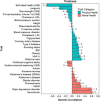Genetic contributions to self-reported tiredness
- PMID: 28194004
- PMCID: PMC5822465
- DOI: 10.1038/mp.2017.5
Genetic contributions to self-reported tiredness
Erratum in
-
Genetic contributions to self-reported tiredness.Mol Psychiatry. 2018 Mar;23(3):789-790. doi: 10.1038/mp.2017.70. Epub 2017 Mar 21. Mol Psychiatry. 2018. PMID: 28322280 Free PMC article.
Abstract
Self-reported tiredness and low energy, often called fatigue, are associated with poorer physical and mental health. Twin studies have indicated that this has a heritability between 6 and 50%. In the UK Biobank sample (N=108 976), we carried out a genome-wide association study (GWAS) of responses to the question, 'Over the last two weeks, how often have you felt tired or had little energy?' Univariate GCTA-GREML found that the proportion of variance explained by all common single-nucleotide polymorphisms for this tiredness question was 8.4% (s.e.=0.6%). GWAS identified one genome-wide significant hit (Affymetrix id 1:64178756_C_T; P=1.36 × 10-11). Linkage disequilibrium score regression and polygenic profile score analyses were used to test for shared genetic aetiology between tiredness and up to 29 physical and mental health traits from GWAS consortia. Significant genetic correlations were identified between tiredness and body mass index (BMI), C-reactive protein, high-density lipoprotein (HDL) cholesterol, forced expiratory volume, grip strength, HbA1c, longevity, obesity, self-rated health, smoking status, triglycerides, type 2 diabetes, waist-hip ratio, attention deficit hyperactivity disorder, bipolar disorder, major depressive disorder, neuroticism, schizophrenia and verbal-numerical reasoning (absolute rg effect sizes between 0.02 and 0.78). Significant associations were identified between tiredness phenotypic scores and polygenic profile scores for BMI, HDL cholesterol, low-density lipoprotein cholesterol, coronary artery disease, C-reactive protein, HbA1c, height, obesity, smoking status, triglycerides, type 2 diabetes, waist-hip ratio, childhood cognitive ability, neuroticism, bipolar disorder, major depressive disorder and schizophrenia (standardised β's had absolute values<0.03). These results suggest that tiredness is a partly heritable, heterogeneous and complex phenomenon that is phenotypically and genetically associated with affective, cognitive, personality and physiological processes.
Conflict of interest statement
IJD is a participant in UK Biobank. The remaining authors declare no conflict of interest.
Figures




References
-
- van’t Leven M, Zielhuis GA, van der Meer JW, Verbeek AL, Bleijenberg G. Fatigue and chronic fatigue syndrome-like complaints in the general population. Eur J Public Health 2010; 20: 251–257. - PubMed
-
- Ricci JA, Chee E, Lorandeau AL, Berger J. Fatigue in the US workforce: prevalence and implications for lost productive work time. J Occup Environ Med 2007; 49: 1–10. - PubMed
Publication types
MeSH terms
Substances
Grants and funding
LinkOut - more resources
Full Text Sources
Other Literature Sources
Medical
Research Materials

